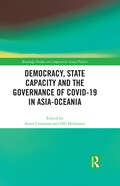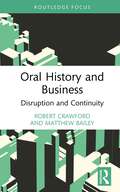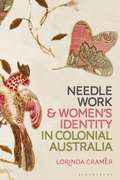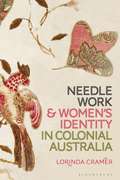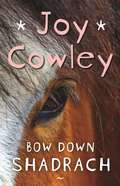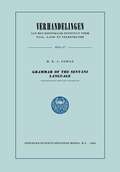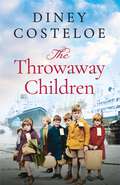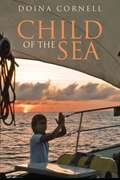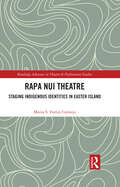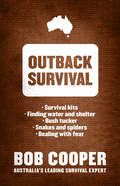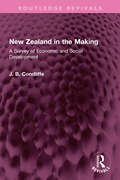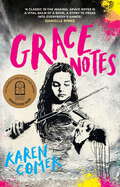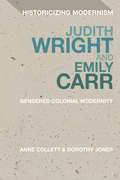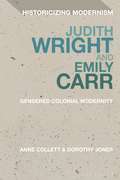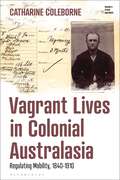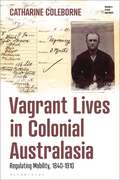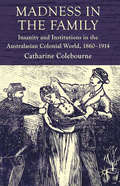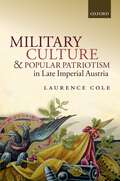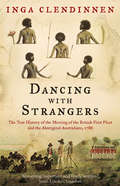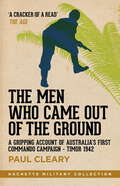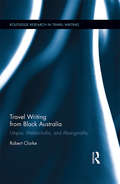- Table View
- List View
Democracy, State Capacity and the Governance of COVID-19 in Asia-Oceania (Routledge Studies on Comparative Asian Politics)
by Aurel Croissant Olli HellmannThis book examines the public health responses to the COVID-19 pandemic in the Asia-Oceania region and their implications for democratic backsliding in the period January 2020 to mid-2021. The contributions discuss three key questions: How did political institutions in Asia-Oceania create incentives for effective public health responses to the COVID-19 outbreak? How did state capacities enhance governments’ ability to implement public health responses? How have governance responses affected the democratic quality of political institutions and processes? Together, the analyses reveal the extent to which institutions prompted an effective public health response and highlights that a high-capacity state was not a necessary condition for containing the spread of COVID-19 during the early phase of the pandemic. By combining quantitative and qualitative analyses, the volume also shows that the effect of the COVID-19 pandemic on the quality of democratic institutions has been uneven across Asia-Oceania. Guided by a comprehensive theoretical framework, this will be an invaluable resource for scholars and students of political science, policy studies, public health and Asian studies.
Oral History and Business: Disruption and Continuity
by Robert Crawford Matthew BaileyThis book introduces business historians to oral history methodologies and approaches. Using four distinct oral history case studies to explore ideas of disruption and continuity in business history over the second half of the twentieth century, Robert Crawford and Matthew Bailey demonstrate how critical engagement with oral history approaches serves to enhance and enliven business history as well as its relationship with other historical fields. The focus on disruption is used to encompass a broad set of processes such as technological change, the impact of external forces, informal business networks, social constructions of gender, knowledge transfer, firm adaptability and cultural change. The use of oral histories to interpret responses to disruption in the past, and to explore the features characterising business continuity, provides an opportunity to consider the human dimensions, subjective experiences and personal insights of workplace, firm and industry change. It also sheds light on the ways that people and firms respond to disruptive forces through innovation and adaptation – both successfully and unsuccessfully. This succinct and accessible account is essential reading for business historians with little experience in using oral history, as well as those looking to gain deeper insights from their oral history data.
Oral History and Business: Disruption and Continuity
by Robert Crawford Matthew BaileyThis book introduces business historians to oral history methodologies and approaches. Using four distinct oral history case studies to explore ideas of disruption and continuity in business history over the second half of the twentieth century, Robert Crawford and Matthew Bailey demonstrate how critical engagement with oral history approaches serves to enhance and enliven business history as well as its relationship with other historical fields. The focus on disruption is used to encompass a broad set of processes such as technological change, the impact of external forces, informal business networks, social constructions of gender, knowledge transfer, firm adaptability and cultural change. The use of oral histories to interpret responses to disruption in the past, and to explore the features characterising business continuity, provides an opportunity to consider the human dimensions, subjective experiences and personal insights of workplace, firm and industry change. It also sheds light on the ways that people and firms respond to disruptive forces through innovation and adaptation – both successfully and unsuccessfully. This succinct and accessible account is essential reading for business historians with little experience in using oral history, as well as those looking to gain deeper insights from their oral history data.
Needlework and Women’s Identity in Colonial Australia
by Lorinda CramerIn gold-rush Australia, social identity was in flux: gold promised access to fashionable new clothes, a grand home, and the goods to furnish it, but could not buy gentility. Needlework and Women's Identity in Colonial Australia explores how the wives, mothers, sisters, and daughters who migrated to the newly formed colony of Victoria used their needle skills as a powerful claim to social standing.Focusing on one of women's most common daily tasks, the book examines how needlework's practice and products were vital in the contest for social position in the turmoil of the first two decades of the Victorian rush from 1851. Placing women firmly at the center of colonial history, it explores how the needle became a tool for stitching together identity. From decorative needlework to household making and mending, women's sewing was a vehicle for establishing, asserting, and maintaining social status.Interdisciplinary in scope, Needlework and Women's Identity in Colonial Australia draws on material culture, written primary sources, and pictorial evidence, to create a rich portrait of the objects and manners that defined genteel goldfields living. Giving voice to women's experiences and positioning them as key players in the fabric of gold-rush society, this volume offers a fresh critical perspective on gender and textile history.
Needlework and Women’s Identity in Colonial Australia
by Lorinda CramerIn gold-rush Australia, social identity was in flux: gold promised access to fashionable new clothes, a grand home, and the goods to furnish it, but could not buy gentility. Needlework and Women's Identity in Colonial Australia explores how the wives, mothers, sisters, and daughters who migrated to the newly formed colony of Victoria used their needle skills as a powerful claim to social standing.Focusing on one of women's most common daily tasks, the book examines how needlework's practice and products were vital in the contest for social position in the turmoil of the first two decades of the Victorian rush from 1851. Placing women firmly at the center of colonial history, it explores how the needle became a tool for stitching together identity. From decorative needlework to household making and mending, women's sewing was a vehicle for establishing, asserting, and maintaining social status.Interdisciplinary in scope, Needlework and Women's Identity in Colonial Australia draws on material culture, written primary sources, and pictorial evidence, to create a rich portrait of the objects and manners that defined genteel goldfields living. Giving voice to women's experiences and positioning them as key players in the fabric of gold-rush society, this volume offers a fresh critical perspective on gender and textile history.
Bow Down Shadrach
by Joy Cowley** Winner of the New Zealand Children's Book of the Year 1990** A classic junior fiction favourite from multi-award winning New Zealand children's author, Joy Cowley.Shadrach is a very old circus-trained Clydesdale horse, and the favourite family pet. When Hannah discovers that Shadrach has been sold to a dog food factory, she decides to mount a heroic rescue and enlists the help of her two younger brothers. From the beginning their plans go seriously wrong. By the time they've argued with the repulsive Wuff Stuff man, hidden Shadrach in a church and a caravan, and floated him on a mussel barge they're in desperate need of rescuing themselves.
Grammar of the Sentani Language (Verhandelingen van het Koninklijk Instituut voor Taal-, Land- en Volkenkunde #47)
by Hendrik Karel CowanThe Throwaway Children
by Diney CosteloeGritty, heartrending and unputdownable – the story of two sisters sent first to an English, then an Australian orphanage in the aftermath of World War II. Rita and Rosie Stevens are only nine and five years old when their widowed mother marries a violent bully called Jimmy Randall and has a baby boy by him. Under pressure from her new husband, she is persuaded to send the girls to an orphanage – not knowing that the papers she has signed will entitle them to do what they like with the children. And it is not long before the powers that be decide to send a consignment of orphans to their sister institution in Australia. Among them – without their family's consent or knowledge – are Rita and Rosie, the throwaway children. What readers are saying about THE THROWAWAY CHILDREN: 'I haven't felt so immersed in a book in a very long time and have recommended to just about everyone' 'Heart wrenching' 'A truly powerful book'
Child of the Sea
by Doina CornellA Child of the Sea is the true story of Jimmy Cornell's daughter sailing around the world on the family's small yacht from the age of 7 to 14, based on Doina's diaries, letters and memories. From 1975 to 1981 the Cornell family visited 54 countries, sailed more than 68,000 miles, and travelled about the same distance overland. The story is told from Doina's point of view, although the main part of the book focuses on the family's three-year stay in the Pacific when she is aged between 10 and 13.Child of the Sea is unusual in that it gives a glimpse into a life that most young children couldn't imagine, swimming, diving and playing the days away in deserted anchorages; visiting some of the most beautiful islands in the world; falling in love with the sea in all its ever-changing moods, from balmy trade wind ocean passages to the treacherous breakers that crash onto tropical reefs, and taking a full part in sailing and handling the yacht on passage. The book also tells the story of a girl's coming of age in the South Pacific, understanding different cultures and values, and experiencing at first-hand how people judge each other depending on the colour of their skin - from the time on Easter Island when tourists mistake Doina for a Polynesian girl, to her and her brother's hostile prejudiced reception back in an English school at the end of their journey.What do children need to grow up happy and healthy? Security with their family; an element of risk; freedom to explore the world; openness to other peoples and cultures; closeness with nature and the elements and an appreciation of the environment and our finite resources. The sailing life offers all this and more, and this book captures it all.
Child of the Sea: A Memoir Of A Sailing Childhood
by Doina CornellA Child of the Sea is the true story of Jimmy Cornell's daughter sailing around the world on the family's small yacht from the age of 7 to 14, based on Doina's diaries, letters and memories. From 1975 to 1981 the Cornell family visited 54 countries, sailed more than 68,000 miles, and travelled about the same distance overland. The story is told from Doina's point of view, although the main part of the book focuses on the family's three-year stay in the Pacific when she is aged between 10 and 13. Child of the Sea is unusual in that it gives a glimpse into a life that most young children couldn't imagine, swimming, diving and playing the days away in deserted anchorages; visiting some of the most beautiful islands in the world; falling in love with the sea in all its ever-changing moods, from balmy trade wind ocean passages to the treacherous breakers that crash onto tropical reefs, and taking a full part in sailing and handling the yacht on passage. The book also tells the story of a girl's coming of age in the South Pacific, understanding different cultures and values, and experiencing at first-hand how people judge each other depending on the colour of their skin - from the time on Easter Island when tourists mistake Doina for a Polynesian girl, to her and her brother's hostile prejudiced reception back in an English school at the end of their journey. What do children need to grow up happy and healthy? Security with their family; an element of risk; freedom to explore the world; openness to other peoples and cultures; closeness with nature and the elements and an appreciation of the environment and our finite resources. The sailing life offers all this and more, and this book captures it all.
Rapa Nui Theatre: Staging Indigenous Identities in Easter Island (Routledge Advances in Theatre & Performance Studies #1)
by Moira Fortin CornejoThis book examines the relationships between theatrical representations and socio-political aspects of Rapa Nui culture from pre-colonial times to the present. This is the first book written about the production of Rapa Nui theatre, which is understood as a unique and culturally distinct performance tradition. Using a multilingual approach, this book journeys through Oceania, reclaiming a sense of connection and reflecting on synergies between performances of Oceanic cultures beyond imagined national boundaries. The author argues for a holistic and inclusive understanding of Rapa Nui theatre as encompassing and being inspired by diverse aspects of Rapa Nui performance cultures, festivals, and art forms. This book will be of great interest to students and scholars of Indigenous studies, Pacific Island studies, performance, anthropology, theatre education and Rapa Nui community, especially schoolchildren from the island who are learning about their own heritage.
Rapa Nui Theatre: Staging Indigenous Identities in Easter Island (Routledge Advances in Theatre & Performance Studies #1)
by Moira Fortin CornejoThis book examines the relationships between theatrical representations and socio-political aspects of Rapa Nui culture from pre-colonial times to the present. This is the first book written about the production of Rapa Nui theatre, which is understood as a unique and culturally distinct performance tradition. Using a multilingual approach, this book journeys through Oceania, reclaiming a sense of connection and reflecting on synergies between performances of Oceanic cultures beyond imagined national boundaries. The author argues for a holistic and inclusive understanding of Rapa Nui theatre as encompassing and being inspired by diverse aspects of Rapa Nui performance cultures, festivals, and art forms. This book will be of great interest to students and scholars of Indigenous studies, Pacific Island studies, performance, anthropology, theatre education and Rapa Nui community, especially schoolchildren from the island who are learning about their own heritage.
Outback Survival
by Bob CooperOutback Survival is a timeless, practical run down on everything you need to know to survive in the outback.Bob Cooper's incredible bushcraft skills have been developed through more than 25 years of experience in Australia's harsh outback. He has picked up tools of survival from the experiences of living with traditional Aboriginal communities, instructing with Special Forces Units, lecturing with the Texas Parks and Wildlife Service on desert survival in the Mexican Desert, delivering wilderness lessons in the UK and learning the skills of the bushmen of the Kalahari Desert in Botswana.Bob has put his own lessons to the test, dropping himself off in the 42C heat of the Australian desert with only a map and soap box sized survival kit, no food, water or sleeping gear, and a 10 day walk across 160km of rough terrain back to safety. He did this alone and showed that with the right knowledge of the land, you can survive in even the harshest of conditions.The outback of Australia is one of the most unforgiving regions of the world, but Bob is committed to protecting and enhancing the experience people have when venturing out into the bush.
New Zealand in the Making: A Survey of Economic and Social Development (Routledge Revivals)
by J. B. CondliffeFirst published in 1930, New Zealand in the Making is an economic history of the democratic experiments in New Zealand. The geography, population, government ownership of public utilities, compulsory arbitration, pensions and all other factors have been covered in detail. The book will be of interest to anyone keen on learning about New Zealand as well as to students of economy, history, agriculture, and government.
New Zealand in the Making: A Survey of Economic and Social Development (Routledge Revivals)
by J. B. CondliffeFirst published in 1930, New Zealand in the Making is an economic history of the democratic experiments in New Zealand. The geography, population, government ownership of public utilities, compulsory arbitration, pensions and all other factors have been covered in detail. The book will be of interest to anyone keen on learning about New Zealand as well as to students of economy, history, agriculture, and government.
Grace Notes
by Karen ComerThis song has a grace note,a tiny note that's there for embellishmentbut can easily be ignored,not played.Tonight, I add it in -just because.We can all do with an extra noteof grace.Grace Dalfinch is a talented violinist who longs to play contemporary music in bars, but her mum forbids her. James Crux is an aspiring street artist who promised his dad he wouldn't paint in public until he's finished school. When Crux witnesses Grace's impromptu performance on a deserted tram, he's inspired to paint her and her violin; and when Grace stumbles across her portrait in a Melbourne alley by an anonymous street artist, she sets out to find its creator.Grace Notes is a debut YA verse novel, set in one of the most locked-down cities in the world - Melbourne, 2020. For fans of Cath Crowley and Pip Harry.'A classic in the making; Grace Notes is a vital balm of a book, a story to press into everybody's hands.'DANIELLE BINKS'Poetry, music and art, woven together in an uplifting story about endless lockdowns and first love.'NOVA WEETMAN'Comer captures the beats of Melbourne's 2020 and the unique experience of a generation of teens in one of the most locked-down cities in the world.'Books+Publishing'Heart and soul triumph over Covid lockdowns and restrictions . . . Karen has used the verse novel to beguile, dance and demand layers of emotion and depth that only poetry can sustain. A masterful debut!'LORRAINE MARWOOD'Like the grace note of the title, this beautiful story strikes the perfect tone, mixing colour, light and music at a time when we needed it most.'NICOLE HAYES
Judith Wright and Emily Carr: Gendered Colonial Modernity (Historicizing Modernism)
by Anne Collett Dorothy JonesKnitting together two fascinating but entirely distinct lives, this ingeniously structured braided biography tells the story of the lives and work of two women, each a cultural icon in her own country yet lesser known in the other's. Australian poet Judith Wright and Canadian painter Emily Carr broke new ground for female artists in the British colonies and influenced the political and social debates about environment and indigenous rights that have shaped Australia and Canada in the 21st century. In telling their story/ies, this book charts the battle for recognition of their modernist art and vision, pointing out significant moments of similarity in their lives and work. Although separated by thousands of miles, their experience of colonial modernity was startlingly analogous, as white settler women bent on forging artistic careers in a male-dominated world and sphere rigged against them. Through all this, though, their cultural importance endures; two remarkable women whose poetry and painting still speak to us today of their passionate belief in the transformative power of art.
Judith Wright and Emily Carr: Gendered Colonial Modernity (Historicizing Modernism)
by Anne Collett Dorothy JonesKnitting together two fascinating but entirely distinct lives, this ingeniously structured braided biography tells the story of the lives and work of two women, each a cultural icon in her own country yet lesser known in the other's. Australian poet Judith Wright and Canadian painter Emily Carr broke new ground for female artists in the British colonies and influenced the political and social debates about environment and indigenous rights that have shaped Australia and Canada in the 21st century. In telling their story/ies, this book charts the battle for recognition of their modernist art and vision, pointing out significant moments of similarity in their lives and work. Although separated by thousands of miles, their experience of colonial modernity was startlingly analogous, as white settler women bent on forging artistic careers in a male-dominated world and sphere rigged against them. Through all this, though, their cultural importance endures; two remarkable women whose poetry and painting still speak to us today of their passionate belief in the transformative power of art.
Vagrant Lives in Colonial Australasia: Regulating Mobility, 1840-1910 (Empire’s Other Histories)
by Catharine ColeborneInvestigating the history of vagrants in colonial Australia and New Zealand, this book provides insights into the histories and identities of marginalised peoples in the British Pacific Empire. Showing how their experiences were produced, shaped and transformed through laws and institutions, it reveals how the most vulnerable people in colonial society were regulated, marginalised and criminalised in the imperial world. Studying the language of vagrancy prosecution, narratives of mobility and welfare, vagrant families, gender and mobility and the political, social and cultural interpretations of vagrancy, this book sets out a conceptual framework of mobility as a field of inquiry for legal and historical studies. Defining 'mobility' as population movement and the occupation of new social and physical space, it offers an entry point to the related histories of penal colonies and new 'settler' societies. It provides insights into shared histories of vagrancy across New South Wales, Victoria, Tasmania and New Zealand, and explores how different jurisdictions regulated mobility within the temporal and geographical space of the British Pacific Empire.
Vagrant Lives in Colonial Australasia: Regulating Mobility, 1840-1910 (Empire’s Other Histories)
by Catharine ColeborneInvestigating the history of vagrants in colonial Australia and New Zealand, this book provides insights into the histories and identities of marginalised peoples in the British Pacific Empire. Showing how their experiences were produced, shaped and transformed through laws and institutions, it reveals how the most vulnerable people in colonial society were regulated, marginalised and criminalised in the imperial world. Studying the language of vagrancy prosecution, narratives of mobility and welfare, vagrant families, gender and mobility and the political, social and cultural interpretations of vagrancy, this book sets out a conceptual framework of mobility as a field of inquiry for legal and historical studies. Defining 'mobility' as population movement and the occupation of new social and physical space, it offers an entry point to the related histories of penal colonies and new 'settler' societies. It provides insights into shared histories of vagrancy across New South Wales, Victoria, Tasmania and New Zealand, and explores how different jurisdictions regulated mobility within the temporal and geographical space of the British Pacific Empire.
Madness in the Family: Insanity and Institutions in the Australasian Colonial World, 1860–1914
by C. ColeborneMadness in the Family explores how colonial families coped with insanity through a trans-colonial study of the relationships between families and public colonial hospitals for the insane in New South Wales, Victoria, Queensland and New Zealand between 1860 and 1914.
Military Culture And Popular Patriotism In Late Imperial Austria
by Laurence ColeMilitary Culture and Popular Patriotism in Late Imperial Austria examines the interplay between popular patriotism and military culture in late imperial Austria. Laurence Cole suggests that two main questions should be asked regarding the western half of the Habsburg Monarchy during the period from the mid-nineteenth century to the outbreak of war in 1914. Firstly, how far did imperial Austrian society experience a process of militarization comparable to that of other European countries? Secondly, how far did the military sphere foster popular patriotism in the multinational state? Various manifestations of military culture, including hero cults and, above all, military veterans associations, provide the main subject for analysis in this volume. After exploring the historical development of military culture in the Habsburg Monarchy, Cole explains how the long reign of Emperor Franz Joseph I constituted a decisive phase in the militarization of Austrian society, with the dynasty and state emphasizing the military's role as the locus of loyalty. Popular manifestations of military culture, such as the hero cult surrounding Field Marshal Radetzky and military veterans associations, complemented the official agenda in many respects. However, veterans associations in particular constituted a political mobilization of the lower middle and lower classes, who asserted their own interests and position in civil society, as is shown by case studies of regions of the Austrian state with significant Italian-speaking populations (Trentino and the Littoral). State attempts to assert greater control of veterans activities led to national and political opposition at a time when tensions over 'militarism' and foreign policy increased. Military Culture and Popular Patriotism in Late Imperial Austria thus raises the question of whether the military was really a bulwark of the multinational state or rather a polarizing force in imperial Austrian society.
Dancing With Strangers: The True History of the Meeting of the British First Fleet and the Aboriginal Australians, 1788
by Inga ClendinnenIn January of 1788 the First Fleet arrived in New South Wales and a thousand British men and women encountered the people who will be their new neighbours; the beach nomads of Australia. "These people mixed with ours," wrote a British observer soon after the landfall, "and all hands danced together." What followed would determine relations between the peoples for the next two hundred years. Drawing skilfully on first-hand accounts and historical records, Inga Clendinnen reconstructs the complex dance of curiosity, attraction and mistrust performed by the protagonists of either side. She brings this key chapter in British colonial history brilliantly alive. Then we discover why the dancing stopped . . .
The Men Who Came Out of the Ground: A gripping account of Australia's first commando campaign
by Paul Cleary'This account . . . is breathtaking in its scope and riveting in its research' - Sydney Morning HeraldThe gripping story of a small force of Australian Special Forces commandos that launched relentless hit and run raids on far superior Japanese forces in East Timor for most of 1942.These Australians were the men of the 2/2nd Australian Independent Company - a special commando unit. Initially stranded without radio contact to Australia, the Japanese declared these bearded warriors ‘outlaws’ and warned they would be executed immediately if captured. The Australians drawn mainly from the bush, were chosen for their ability to operate independently and survive in hostile territory. As film-maker Damien Parer said after visiting in Timor in late 1942, ‘these men are writing an epic of guerrilla warfare’.Expertly researched by Paul Cleary, who is fluent in Tetum, the main language of the indigenous group of East Timor, it also contains insightful black and white photos.'A cracker of a read' - The Age'Paul Cleary has brought to life one of the great success stories of World War II' - Daily Telegraph
Travel Writing from Black Australia: Utopia, Melancholia, and Aboriginality (Routledge Research in Travel Writing)
by Robert ClarkeOver the past thirty years the Australian travel experience has been ‘Aboriginalized’. Aboriginality has been appropriated to furnish the Australian nation with a unique and identifiable tourist brand. This is deeply ironic given the realities of life for many Aboriginal people in Australian society. On the one hand, Aboriginality in the form of artworks, literature, performances, landscapes, sport, and famous individuals is celebrated for the way it blends exoticism, mysticism, multiculturalism, nationalism, and reconciliation. On the other hand, in the media, cinema, and travel writing, Aboriginality in the form of the lived experiences of Aboriginal people has been exploited in the service of moral panic, patronized in the name of white benevolence, or simply ignored. For many travel writers, this irony - the clash between different regimes of valuing Aboriginality - is one of the great challenges to travelling in Australia. Travel Writing from Black Australia examines the ambivalence of contemporary travelers’ engagements with Aboriginality. Concentrating on a period marked by the rise of discourses on Aboriginality championing indigenous empowerment, self-determination, and reconciliation, the author analyses how travel to Black Australia has become, for many travelers, a means of discovering ‘new’—and potentially transformative—styles of interracial engagement.
